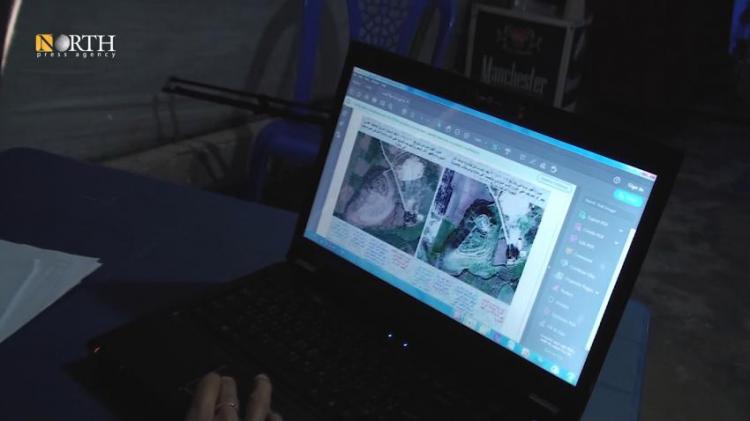Footage from Afrin shows the plundering of the Basaltic Lion by Turkey and its affiliates
Northern Aleppo – North-Press Agency
Dejla Khalil
Since the control of the Turkish military and its affiliated armed groups on Afrin in March of last year, they pursued a strategy of demographic change in the Syrian-Kurdish region as the continued violation reached to the material and cultural heritage of the city. During its military invasion in Afrin, the Turkish military and the affiliated armed opposition groups have targeted the archaeological sites, continuing to bulldoze hills and archaeological sites using heavy machinery, which in turn destroyed the archaeological layers.
Ain Dara archaeological site was one of the most archaeological sites that were systematically destroyed, as the hill was bombed by the Turkish warplanes, which led to the destruction of more than 60% of the architectural block area of Ain Dara Temple, in addition to bulldozing and destructive excavations by heavy machinery, according to the Authority of Antiquities in Afrin region.
After the opposition website “Syria Call” published a videotape of the National Liberation Front as it was conducting military training on the ancient hill of Ain Dara, it became clear that the great Basaltic Lion has disappeared from the hill, as the hill was turned into a military training base for the Turkish-backed armed groups.
Regarding the importance of the basaltic lion sculpture, the archaeologist Salah Sino told North-Press: "The basaltic lion is considered as one of the most prominent features of the temple, which has a weight of about 12 tons and a length of 3,3 meters, while its height reaches 70,2 cm.”
He added that on 11 July of last year, a number of pictures were published for the hill of Ain Dara showing the works of bulldozers as they dig the hill, and we have checked that the coordinates of the photos belong to the site of Ain Dara.”
Mr. Sino added that they have confirmed the disappearance of the Basaltic Lion sculpture after they obtained new photographs dating back to August 21, adding that they have compared them with the old satellite images dating back to January 29 2018, a period when the Turkish forces attacked Afrin, where recent pictures show the disappearance of the lion from the hill. He also confirmed that they had documented the conversion of the archaeological hill into a military training site, where the Syrian opposition media website "Syria Call" published two videotapes showing the conversion of the hill into a military training site, while using live hand grenades at the archaeological site.
Salah Sino pointed out that there are many archaeological sites that are located in Afrin region and have been subjected to digging, destruction and theft by the Turkish military and its affiliated armed groups, noting that they are having difficulties in obtaining pictures from the archaeological sites that are under the occupation of the Turkish forces.
Mr. Sino appealed to UNESCO and the international community to work with the laws and decisions approved by the Security Council No. 2139 of 2014, which called on all Syrian parties to preserve the heritage in order to protect the Syrian cultural diversity.
The ancient hill of Ain Dara is located 1 km to the west of the current village of Ain Dara, at a distance of about 5 km to the south of city of Afrin, surrounded by fertile plains on three sides, as it bounded to Afrin River, to the west about 800 meters away. The site also penetrates the spring stream of Ain Dara, which runs from its small lake to flow into Afrin River, west of the hill.
The archaeological site (the hill of Ain Dara) is currently made up of monuments and a temple containing various statues, representing winged animals, statues for the Sphinx and many inscriptions and monuments, and a basalt painting representing the goddess Ishtar has been found at the site. Ain Dara Temple was discovered in 1956, by a national archaeological mission, where the temple dates back to the modern period, which is about 1250 BC.

